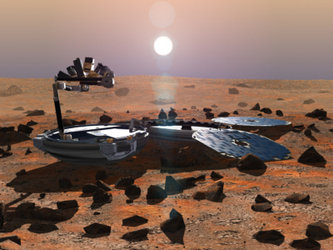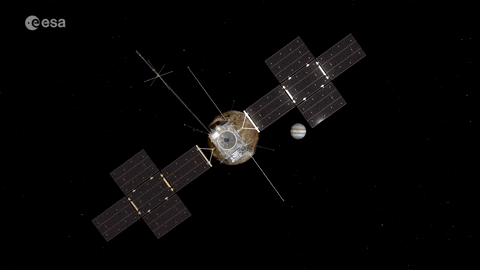Testing times: An interview with Con McCarthy
Con McCarthy, Mars Express Beagle 2 Manager, has faced countless challenges over the last few years. But Beagle 2, due to land on Mars on Christmas morning, will be the culmination of his enormous commitment to this project - making European history.

Cornelius (“Con”) McCarthy
Mars Express Beagle 2 Manager
Born: 23 April 1943 in Cork, Republic of Ireland
BSc degree in Electrical/Electronic Engineering, University of North London.
Having worked on computer-based radar processing systems in the UK and Italy, Con took his first job in the space field working on the European 'Spacelab' in Bremen, Germany, which was one of the first ESA contributions to human spaceflight.
He joined ESA in 1982, to work on the second Spacelab mission, then ERS-1 Earth Observation satellite. He was Systems Engineer on ESA’s Huygens mission, due to land on Saturn’s moon Titan in 2005, before taking his present position in 1998.
Married with two grown-up sons, Con likes to 'get his hands dirty’ in his spare time, rebuilding the engine of a 1969 Rover P5 car, as well as flying light aircraft.
The possibility that we will find out something that has never been found before is irresistible.
ESA: You have devoted the last five years to the Mars Express lander Beagle 2. Why is landing on Mars so important to you?
Con McCarthy
Europe’s first attempt to land on Mars represents an enormous challenge. We are all too aware that two thirds of the previous attempts have failed so, in a sense, we are attempting the impossible. But, at the same time, the possibility that we will find out something that has never been found before is irresistible.
So we have taken the knowledge base that has been built up over all the previous Mars missions, and used it to design a mission that will extend that knowledge base. Then, all subsequent missions will take what we find and use it to find out even more. Mars Express is not isolated in that respect – it is building up knowledge for the future.
ESA: How has the knowledge we currently have about Mars been put to practical use for this mission?
Con McCarthy
A good example was when we were deciding where Beagle 2 should land. Using information obtained by the US orbiters, we were able to calculate the probable wind strengths on Mars in order to determine a landing site which would ensure Beagle 2 has the best chance of surviving the impact. We also used information from the Pathfinder Rover which went to Mars in 1997 and found that all Martian rocks were sandblasted by the strong winds, leaving a hard layer of silicon on their surface. In response to this, we added an abrasion tool to Beagle 2 so that we can find out what is underneath this layer.
This is a whole new way of operating for ESA, but one we will see more of in the future.
ESA: What specific challenges have you faced in bringing Beagle 2 to fruition?
Con McCarthy
The main challenge has been that this has not been a classic ESA project. Normally, ESA would work out what its requirements were for the spacecraft, or the instrument, and then commission it from a specific team or company. In this instance, ESA was just one partner in a consortium that included industrial partners, academics and other organisations. This meant that I had to work in a much more co-operative sense rather than as a project manager.
This is a whole new way of operating for ESA, but I think it is one that we will be seeing more of in the future. We also had huge constraints in terms of how quickly we had to design and build the probe – we couldn’t miss the deadline of the launch date, as this was when Mars was going to be at its closest to Earth in many thousands of years. It was also a challenge to keep the Beagle 2 mass to less than 65 kilograms, as that was all that Mars Express could carry.
ESA: What will be the most exciting moment for you once the Beagle 2 has landed?
Con McCarthy
Well, we have built special communications equipment that allows Beagle 2 to communicate via the US Mars Odyssey orbiter when it first arrives on Mars. We had to do this because, once it has jettisoned Beagle 2 towards the planet, Mars Express will not pass over the landing site again until 4 January 2004.
On Christmas morning, we hope that Beagle 2 will be able to send us a message via Mars Odyssey. But even if that message doesn’t arrive, we have made a plan to use the huge radio telescope at Jodrell Bank Observatory at the University of Manchester in the UK to listen for the ‘beep’ that Beagle 2 will automatically transmit on landing. When we hear that, it will be a very exciting moment.
All of us could technically be Martians – wouldn’t that be great?
ESA: How did you come to work in space science?
Con McCarthy
Well, it was by coincidence really. I was waiting to catch the ferry from Cork over to Wales with my young family and I bought a newspaper. The journey was several hours, and so I read this paper from cover to cover, including all the advertisements, when I spotted the job to work on the European Space Laboratory. I thought that it sounded interesting. I actually wrote my application on the boat there and then, although I tidied it up once I got home, of course.
ESA: Finally, what do you hope Beagle 2 will find?
Con McCarthy
We all dream of finding signs of past or present life on Mars. But for me, I think it would be fantastic if we could prove that it was a meteorite from Mars that originally brought the first magic spark to Earth that triggered the evolution of life over the next few billion years. That would make all of us technically Martians - wouldn't that be great?








